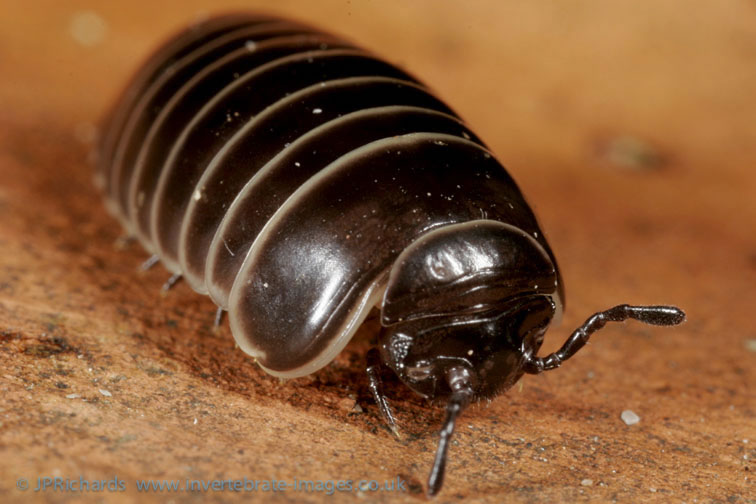Glomeris marginata (Villers, 1789)
Common name
Status:
GB IUCN status: Least Concern
ID Difficulty
Identification
The pill millipedes, Glomeridae, are distinctive short stout millipedes that are able to roll into a defensive ball when disturbed. When adult they have just twelve arched body tergites (including the collum and the telson) bearing 17 (female) or 19 (male) pairs of legs.
Glomeris marginata is a distinctive, usually darkly pigmented millipede, reaching 20 mm in length (in stark contrast to the other three Glomeridae). It is unlikely to be confused with any other British or Irish millipede and is readily identified from a photograph. However, it is frequently mistaken for pill woodlice (such as Armadillidium vulgare) by inexperienced recorders. The last body segment of Glomeris is undivided but in the woodlice it appears to be split into three smaller segments. Also, when the animal is enrolled Glomeris is more egg shaped compared to the more spherical balls formed by pill woodlice.
Distribution
This species is widespread and common in England, Ireland and Wales but is not found north of the Midland Valley in Scotland. It is believed to be restricted by low temperature (Kime, 1995) and is rarely found at altitudes above 300m. Kime (2004) reported a similar situation from the Ardennes in Belgium.
In Europe this millipede is found eastwards to Poland and from the Pyrenees to southern Norway (Kime, 1990). It is most common in the west and is restricted to lower altitudes and coastal areas further east (Kime, 1995).
Habitat
Although it has been recorded from a wide range of habitats and soils, this species is most typically found in deciduous woodland on calcareous loam soils. Habitat data analysis also suggests a strong association with bare rock, including screes, but strong negative relationships with sand dunes and with disturbed, human influenced sites including cultivated land, waste ground and churchyards. In Flanders, Van Den Haute (1999) has shown calcium content of the soil to be the most important factor determining abundance of the species.
Phenology
Males mature in their second or third year, females in their third or fourth year. Adults can be found throughout the year but are collected most frequently in the spring and autumn. Individuals may survive to an age of 10-11 years (Heath, Bocock & Mountford, 1974).
This species account is based on Lee (2006).
References
Heath, J., Bocock, K.L. & Mountford, M.D. 1974. The life history of the millipede Glomeris marginata (Villers) in north-west England. Symposia of the Zoological Society of London, 32, 433-462.
Kime, R.D. 2004. The Belgian Millipede Fauna (Diplopoda). Bulletin del’Institut royal des SciencesNaturelles de Belgique, Entomologie, 74, 35-68.
Kime, R.D. 1995. Records of millipedes in central southern England. Bulletin of the British Myriapod Group, 11, 37-58.
Kime, R.D. 1990. A provisional Atlas of European Myriapods Part 1. Fauna Europaea Evertebrata Vol 1.
Van Den Haute, L. 1999. Faunistiek en ecologie van Diplopoda (Myriapoda) in Vlaamse bossen. Unpublished thesis, University of Ghent.
Links
MilliBase - Global catalogue of Millipedes: https://millibase.org/aphia.php?p=taxdetails&id=945075













